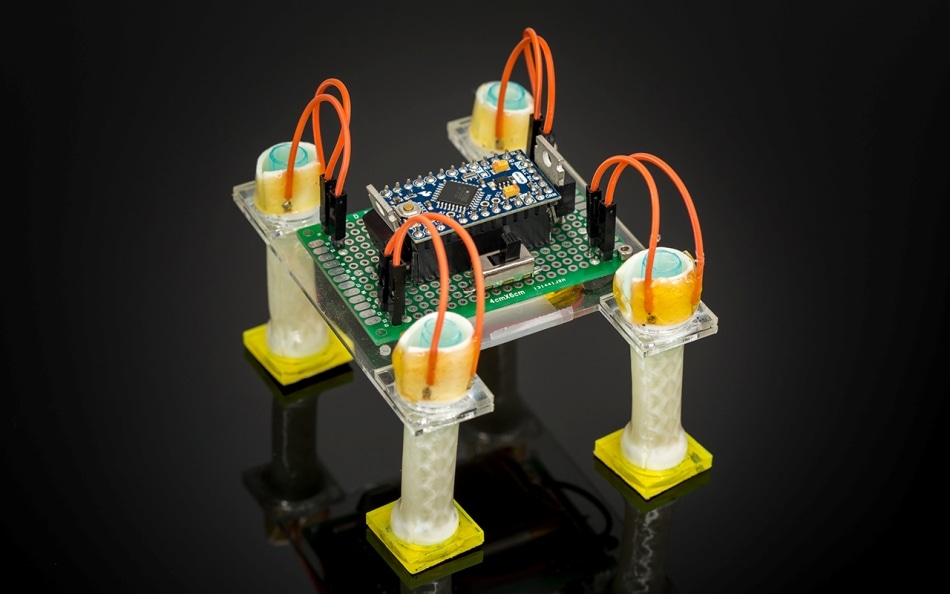Oct 14 2019
A novel method to construct soft robots that are multifunctional, small, and portable has been developed by engineers from the University of California San Diego.
 Electrically controlled, untethered soft robot built out of four soft tubular actuators, a microcontroller, and battery. The robot can be programmed to walk or carry an object. (Image credit: David Baillot/UC San Diego Jacobs School of Engineering)
Electrically controlled, untethered soft robot built out of four soft tubular actuators, a microcontroller, and battery. The robot can be programmed to walk or carry an object. (Image credit: David Baillot/UC San Diego Jacobs School of Engineering)
This innovation was made viable by building soft, tubular actuators whose movements are electrically regulated, which makes it easy to incorporate them into small electronic components.
The engineers used these new actuators as a proof of concept to construct an untethered, soft, battery-driven robot with the ability to walk on flat surfaces and move things around. They also developed a soft gripper with the potential to grab and pick up small things.
The research team was guided by Shengqiang Cai, professor of mechanical and aerospace engineering at UC San Diego. The study has been reported in the October 11th issue of Science Advances.
An issue with a majority of the soft actuators is that they are made of bulky configurations. That is because their movements are regulated by pumping either fluids or air through inner chambers. Therefore, constructing robots with these kinds of actuators would necessitate tethering them to large power sources, pumps, and other dedicated equipment.
In this study, the UC San Diego engineers built soft actuators that are regulated with electricity.
This feature makes our tubular actuators compatible with most low-cost, commercially available electronic devices and batteries.
Shengqiang Cai, Professor of Mechanical and Aerospace Engineering, UC San Diego
The actuators are manufactured using a kind of material that is used to develop artificial muscles in robots, known as liquid crystal elastomers. They are made up of liquid crystal molecules embedded in a flexible polymer network.
The unique feature of these materials is that they change shape, contract, and move in response to stimuli like electricity or heat—quite similar to the way muscles contract in reaction to signals from nerve cells.
The researchers built each actuator by sandwiching three heating wires between two thin films of liquid crystal elastomer. Subsequently, the material was rolled into a tube, pre-stretched, and exposed to ultraviolet light.
All the heating wires are regulated individually so that the tube can be bent in six different ways. Upon passing electricity through one or two of the wires, a portion of the tube is heated up, bending it in the direction of those wires.
When electricity is passed via all three wires, the whole tube tends to contract, causing the length to shorten. Upon switching off the electricity, the tube gradually cools down and regains its original shape.
Using an externally applied electrical potential makes it easy to program the position of each tubular actuator.
Qiguang He, Study First Author and PhD Student, Mechanical and Aerospace Engineering, UC San Diego Jacobs School of Engineering
By combining a number of actuators, the engineers were able to develop various types of soft robots. Using four actuators as legs, they created an untethered, walking robot. This robot is driven by a small lithium/polymer battery on board. They also designed a soft gripper with three actuators acting as fingers.
The robots have an on-board microcontroller, wherein the engineers have programmed a sequence of electrically regulated motions for the actuators. This enables the robots to move freely.
The researchers are currently involved in building soft actuators with the ability to move faster. The existing actuators require about 30 seconds to totally bend and contract, and up to 4 minutes to get back to their primary shapes.
This is because the material requires some time to completely heat up and cool down. The ultimate aim is to create actuators capable of contracting and relaxing as swiftly as human muscles, stated He.
Co-authors of the research paper titled “Electrically controlled liquid crystal elastomer-based soft tubular actuator with multimodal actuation” include Zhijian Wang, Yang Wang, Adriane Minori, and Michael T. Tolley, all from UC San Diego.
This research was funded by the Office of Naval Research (grant N00014-17-1-2062) and the National Science Foundation (grant CMMI-1554212). This study was conducted partly at the San Diego Nanotechnology Infrastructure (SDNI) at UC San Diego, a member of the National Nanotechnology Coordinate Infrastructure, which is aided by the National Science Foundation (grant ECCS-1542148).
Electrically controlled soft actuators
Video credit: UC San Diego Jacobs School of Engineering